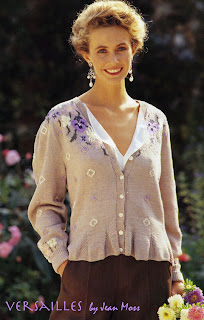Versailles Jacket
I've never really been fond of grappling with intarsia myself, but it took me years of designing before I realised that with challenging techniques knitters need rest rows. This design was on the cover of my first book Designer Knits Collection way back in 1990, incorporating intarsia, texture and godets. I was reminded of it the other day when someone ordered the pattern.
Unfortunately it's only in one size. I have to admit the reason for this was not something I would now recommend. At the time I was doing design and production for several US design houses and they would order large runs of one design. We used to have about 2000 knitters around the UK and no matter how hard I tried, quality control was always a problem, especially sizing! So my solution was to only ever write a medium size pattern and from that we could be fairly sure that we would get a cross section of sizes to fullfil the orders. Crazy I know but true - I'm sure knitters are more diligent now with their swatching and produce garments of the size the pattern intended.
The jacket was also resurrected by Rowan in their their 30th anniversary magazine (No 44, unfortunately modelled by me looking uncomfortable on a windswept moor, one of my least favourite pics ever!) done in 4-py soft. Their original version was featured in magazine 9 in mercerised cotton, one of my favourite Rowan yarns of all time - fabulous stitch definition and only beaten by Wool Cotton, although I have to admit I was suicidal when Lightweight DK was discontinued.
So... back to the technique of intarsia. An orderly mind is required. I use the same method as my friend Sasha Kagan - separate balls for each of the contrast colours each time they occur on the row, weaving or stranding the main colour behind and twisting each new colour as it occurs around the previous colour to avoid holes. This cuts down on the number of ends and gives the contrast colours a slightly raised effect, which helps define the pattern. For intarsia with random shapes and no background colour, use a separate length of yarn for each colour every time it occurs, twisting the two colours around each other as before to avoid holes. To get rid of tangles, either wrap each length around a separate piece of card and dangle on back of work or treat yourself to the readymade version available in most yarn shops; alternatively use short lengths of yarn (no longer than 24”/61cm and run your fingers through the strands to untangle at end of each row.
Good day for our tours today, three new knitters signed up for Knit Ireland - I'm getting really excited and it's still a year away!
Unfortunately it's only in one size. I have to admit the reason for this was not something I would now recommend. At the time I was doing design and production for several US design houses and they would order large runs of one design. We used to have about 2000 knitters around the UK and no matter how hard I tried, quality control was always a problem, especially sizing! So my solution was to only ever write a medium size pattern and from that we could be fairly sure that we would get a cross section of sizes to fullfil the orders. Crazy I know but true - I'm sure knitters are more diligent now with their swatching and produce garments of the size the pattern intended.
The jacket was also resurrected by Rowan in their their 30th anniversary magazine (No 44, unfortunately modelled by me looking uncomfortable on a windswept moor, one of my least favourite pics ever!) done in 4-py soft. Their original version was featured in magazine 9 in mercerised cotton, one of my favourite Rowan yarns of all time - fabulous stitch definition and only beaten by Wool Cotton, although I have to admit I was suicidal when Lightweight DK was discontinued.
So... back to the technique of intarsia. An orderly mind is required. I use the same method as my friend Sasha Kagan - separate balls for each of the contrast colours each time they occur on the row, weaving or stranding the main colour behind and twisting each new colour as it occurs around the previous colour to avoid holes. This cuts down on the number of ends and gives the contrast colours a slightly raised effect, which helps define the pattern. For intarsia with random shapes and no background colour, use a separate length of yarn for each colour every time it occurs, twisting the two colours around each other as before to avoid holes. To get rid of tangles, either wrap each length around a separate piece of card and dangle on back of work or treat yourself to the readymade version available in most yarn shops; alternatively use short lengths of yarn (no longer than 24”/61cm and run your fingers through the strands to untangle at end of each row.
Good day for our tours today, three new knitters signed up for Knit Ireland - I'm getting really excited and it's still a year away!



Comments
Post a Comment
Thanks for dropping by, please leave your message here.